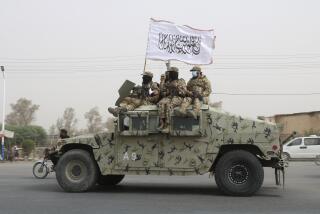U.N. Peace Mission Flies to Afghanistan to End Killing : Asia: Toll put at 2,500 killed and 17,000 injured in Kabul. Half of the capital’s population may have fled.
- Share via
NEW DELHI — With Afghanistan’s capital reduced to a shell-battered moonscape inhabited by thousands of hungry, homeless people, a U.N. peace mission flew to Kabul over the weekend to try to broker an end to nearly two years of brutal fratricide.
“Finding a solution is the main, if not the only, aim of our visit,” the leader of the five-member mission, former Tunisian Foreign Minister Mahmoud Mestiri, told reporters on his arrival in Kabul from Pakistan.
The visit by the U.N. delegation was prompted by the unparalleled fighting that began in January in and around the mountain-ringed capital--and the harsh consequences for the civilian population.
An estimated 2,500 people have been killed and 17,000 injured in the street battles, artillery duels and aerial attacks that have raged in Kabul, the International Committee of the Red Cross said.
Although no one knows for sure, half of the city’s civilian population may have fled, leaving behind about 800,000 people.
Many who stayed have been uprooted by the street-to-street fighting and are living in overcrowded, unsanitary public buildings. As the weather warms up, health officials fear outbreaks of cholera and other diseases.
“It is clear that several hundred thousand people living in Kabul don’t have a basic income to feed their families and don’t have regular access to relief supplies,” Martin Barber, acting director of the U.N. Office for Coordination of Humanitarian Assistance to Afghanistan, said in Islamabad, Pakistan.
For many, food has become the most pressing need. Warfare has deprived most Kabul residents of their paying jobs and simultaneously kept food supplies out. On Saturday, four private organizations distributed 90 tons of wheat flour that had been trucked in from Pakistan, Barber said, but that will only provide rations to 25,000 people for 10 days.
The main belligerents, President Burhanuddin Rabbani and his archrival, Prime Minister Gulbuddin Hekmatyar, a hard-line Muslim fundamentalist, agreed to a cease-fire during the U.N. delegation visit, which should end today or Tuesday.
According to U.N. officials, the Tunisian diplomat wants the widest possible exposure to Afghan leaders and ordinary people to see how the United Nations might best help stanch the Afghan bloodshed.
After the Muslim moujahedeen took power from a Soviet-backed regime in April, 1992, ending 14 years of civil war, a new kind of fighting began--among rival members of the Islamic coalition government. More than 11,000 people have been killed as a result.
Hekmatyar, who has had Pakistani backing, wants Rabbani to resign so an interim government can oversee new elections. The pro-Rabbani Cabinet countered March 25 with a proposed new political setup, whose keystone would be the U.N.-monitored convening of a loya jurga, or great assembly, whose decisions are obligatory for all Afghans.
But Hekmatyar held fast Sunday, telling the U.N. peace mission that Rabbani’s resignation is the only way to end the fighting.
More to Read
Sign up for Essential California
The most important California stories and recommendations in your inbox every morning.
You may occasionally receive promotional content from the Los Angeles Times.













